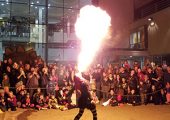List of "Fire Friendly" clothing retailers for fire performers.
Are you looking for fire safe clothing, costumes, and outfits to wear while performing with fire? Then you've come to the right place! Here, we will discuss what makes clothing "fire safe" regarding fire performances and performers, and where to buy them.
First, let's talk about what makes clothing and costuming "fire safe".
What makes clothing fire resistant has to do with fiber content, fabric weight, weave, and fit. Fire resistance is the length of time the fabric can resist ignition with exposure to fire.
The main defining factor in this is the fiber content. Natural fibers are derived from plants and animals and synthetic fibers are usually petroleum based. Examples of natural fibers are cotton, leather, rayon, silk, wool, bamboo, hemp, and denim. Examples of synthetic fibers are nylon, polyester, and acrylic. However, there are synthetic fibers known as Aramids which are highly fire resistant. Some of these are Kevlar, Nomex, CarbonX, PBI, and Panther felt.
Natural fibers, when burnt, simply turn to ash as they burn.
Synthetic, non-aramid fibers, melt as they burn. This is the main concern with clothing and costumes for fire performers. When you're performing, if a synthetic fabric catches and starts to burn, it will melt, drip, and fuse to your skin as it does so causing intense burns. Your main goal as a fire performer is to avoid this at all costs.
There are also natural/synthetic blends. You want to aim for around 90-95% of the natural fiber in this scenario to avoid characteristics of the synthetic involved. The less natural fiber in the blend, the more "melty" it will be. You can do your own burn tests at home to observe the resistance and reaction of any blends that you may have to determine whether or not the fabric is suitable for performing.
The second defining factor is weight and weave. Weight is the thickness of the fabric itself and the weave is how tight or how loose the fabric is woven.
As you can imagine, if a fabric is loosely woven, more oxygen can get into each weave creating a higher flammability of that particular fabric. If it is tighter, less oxygen can get into each weave making it less flammable. Think about this in terms of a fleece throw vs a crocheted blanket. One is very open and one is very closed. The tighter the weave, the less flammable it is.
As for weight, the thicker the fabric, the more fire resistant it is. Even though silk and cotton are both natural fibers, a thin silk shirt will catch fire faster than a thick cotton shirt. And remember that each type of fiber has its own resistance, so one may be more resistant than the other naturally.
And lastly, the fit of the clothing is very important in terms of fire resistance. A loose and flowing pair of pants allows oxygen to come from both sides and flow through the weave and has a greater chance of contact with the fire. A tight fitting pair of pants allows oxygen to come from only one side, doesn't allow the oxygen to flow through, and has a less chance of contact with the fire as it is less material in a smaller amount of space. Avoid anything with frays and fringe.
These three components are the most important when deciding what outfit is appropriate for performing with fire or not.
Fire retardants are an additive treatment to the clothing with chemicals so that the fabric retards the fire. Fire retardants are not recommended for clothing that are to be in contact with the skin as it is an irritant. Please read the SDS (formerly MSDS) sheet on any chemical fire retardant you are looking to spray your costuming with. Fire retardants are water soluble chemicals and cannot be washed, get wet, or withstand high humidity environments. Once wet, washed, etc, they need to be retreated. This goes for Duvetyne as well.
If you absolutely must wear synthetic fibers while performing, it is recommended and highly advised that you wear a heavy weight, tight weave cotton base underneath to deter the fusing of the synthetic fibers to your skin upon melting.
Always remember, just because something is of "natural fiber" does not mean it can't or won't catch on fire. Nothing is fireproof. It WILL catch, it WILL burn. It just depends on the fiber content, weave, weight, and fit to determine how quickly it will catch on fire and how it will burn.
I also want to discuss natural but rare fibers some people may want to wear while performing. This includes fur and feathers. These, although they will not melt, are very extremely loosely woven and will ignite very very quickly and travel through the garment and should be avoided at all costs.
With all this in mind, here are the following companies that offer "fire safe" clothing.
Again, please remember that although these companies offer natural, Aramid, or mainly natural blended fabrics, nothing is fire proof and it is up to you to do your own burn tests and take into account your own risk involvement when it comes to performing with fire. To reduce your risk further, squeeze or spin off all props prior to performing to reduce the risk of fuel transfer.
First, let's talk about what makes clothing and costuming "fire safe".
What makes clothing fire resistant has to do with fiber content, fabric weight, weave, and fit. Fire resistance is the length of time the fabric can resist ignition with exposure to fire.
The main defining factor in this is the fiber content. Natural fibers are derived from plants and animals and synthetic fibers are usually petroleum based. Examples of natural fibers are cotton, leather, rayon, silk, wool, bamboo, hemp, and denim. Examples of synthetic fibers are nylon, polyester, and acrylic. However, there are synthetic fibers known as Aramids which are highly fire resistant. Some of these are Kevlar, Nomex, CarbonX, PBI, and Panther felt.
Natural fibers, when burnt, simply turn to ash as they burn.
Synthetic, non-aramid fibers, melt as they burn. This is the main concern with clothing and costumes for fire performers. When you're performing, if a synthetic fabric catches and starts to burn, it will melt, drip, and fuse to your skin as it does so causing intense burns. Your main goal as a fire performer is to avoid this at all costs.
There are also natural/synthetic blends. You want to aim for around 90-95% of the natural fiber in this scenario to avoid characteristics of the synthetic involved. The less natural fiber in the blend, the more "melty" it will be. You can do your own burn tests at home to observe the resistance and reaction of any blends that you may have to determine whether or not the fabric is suitable for performing.
The second defining factor is weight and weave. Weight is the thickness of the fabric itself and the weave is how tight or how loose the fabric is woven.
As you can imagine, if a fabric is loosely woven, more oxygen can get into each weave creating a higher flammability of that particular fabric. If it is tighter, less oxygen can get into each weave making it less flammable. Think about this in terms of a fleece throw vs a crocheted blanket. One is very open and one is very closed. The tighter the weave, the less flammable it is.
As for weight, the thicker the fabric, the more fire resistant it is. Even though silk and cotton are both natural fibers, a thin silk shirt will catch fire faster than a thick cotton shirt. And remember that each type of fiber has its own resistance, so one may be more resistant than the other naturally.
And lastly, the fit of the clothing is very important in terms of fire resistance. A loose and flowing pair of pants allows oxygen to come from both sides and flow through the weave and has a greater chance of contact with the fire. A tight fitting pair of pants allows oxygen to come from only one side, doesn't allow the oxygen to flow through, and has a less chance of contact with the fire as it is less material in a smaller amount of space. Avoid anything with frays and fringe.
These three components are the most important when deciding what outfit is appropriate for performing with fire or not.
Fire retardants are an additive treatment to the clothing with chemicals so that the fabric retards the fire. Fire retardants are not recommended for clothing that are to be in contact with the skin as it is an irritant. Please read the SDS (formerly MSDS) sheet on any chemical fire retardant you are looking to spray your costuming with. Fire retardants are water soluble chemicals and cannot be washed, get wet, or withstand high humidity environments. Once wet, washed, etc, they need to be retreated. This goes for Duvetyne as well.
If you absolutely must wear synthetic fibers while performing, it is recommended and highly advised that you wear a heavy weight, tight weave cotton base underneath to deter the fusing of the synthetic fibers to your skin upon melting.
Always remember, just because something is of "natural fiber" does not mean it can't or won't catch on fire. Nothing is fireproof. It WILL catch, it WILL burn. It just depends on the fiber content, weave, weight, and fit to determine how quickly it will catch on fire and how it will burn.
I also want to discuss natural but rare fibers some people may want to wear while performing. This includes fur and feathers. These, although they will not melt, are very extremely loosely woven and will ignite very very quickly and travel through the garment and should be avoided at all costs.
With all this in mind, here are the following companies that offer "fire safe" clothing.
Again, please remember that although these companies offer natural, Aramid, or mainly natural blended fabrics, nothing is fire proof and it is up to you to do your own burn tests and take into account your own risk involvement when it comes to performing with fire. To reduce your risk further, squeeze or spin off all props prior to performing to reduce the risk of fuel transfer.
www.HarmonicThreads.xyz
Use discount code SASHA for 10% off at checkout.
Fabric Content: Cotton Spandex (base option): Made from light-medium weight blend. 95% cotton 5% spandex
French Terry and Stretch Fleece: These are both warmer, thicker options for colder climates. Both are a 95% cotton 5% spandex.
Organic Fabric: Hemp/Cotton/Spandex: Made from a light-medium weight blend. 53% Hemp, 44% Organic Cotton, 3% spandex.
Organic Bamboo French Terry: A thicker and warmer option that works wonderfully for leggings. 66% Bamboo, 28% Organic Cotton, 6% spandex.
Women: leggings, ruffle shorts, stripe leggings, bellbottom, flared, and yoga pants, hooded shrugs, bustle shorts, wrap tops, ringmaster circus vest, booty shorts, crop tops, elvish and fiary tops, fleece leggings, high waisted shorts, wrap leggings, halter tops, pocket leggings, criss cross and strappy tops, turtle neck shrug, capri pants, cloaks, skirted leggings, bustle leggings, romper, bodysuit, ruffle romper, pointy hood tops, bralette, dresses, stripe shorts, high waist harem pants, onesie, bustle dress, tunics, skirts, gathered cinched skirts, gathered cinched skirts, pants suit.
Men: Joggers, pullover pocket hoodies, asymmetrical tee, asymmetrical tops, kalen top, ronan pants, avery pants, triptych tee, mock henley, harem and fisherman pants, pointy capri, durin pants, deltoid tee.
www.TheFairiesPyjamas.com
Fabric content: Organic knit stretchy cotton blend. 95% cotton, 5% lycra. Belts, bags, holsters, and jackets are 100% cotton twill.
Women: Leaf skirts, panel skirt, shrugs, tube tops, ruffle shorts, sleeves, dresses, tunics, garter pants, booty shorts, hooded tops, hooded dress, jumpsuits, flapper leaf skirts, high waisted shorts, criss cross and strappy pixie top, gathered shorts, crop sweater, holster vests, onesie, sweaters, leggings, halter tops, harem pants, vest, tutu, mermaid skirt, druid dress, wide legged pants, capri pants, yoga pants.
Men: Genie pants and fisherman pants, button up, vests, holsters, tanks, shorts, elvish clothing, zip off pants, cargo pants and shorts.
The Adventures of Rabbit and Empee
Fabric content: 100% organic cotton heavy duty canvas: Used in several vests, men's pants, and shorts.
Knit items are 90% organic cotton and 10% Lycra.
Stretchy woven items are 97% Organic Cotton and 3% Lycra.
Women: Lotus skirt, asymmetrical skirts, sports bras, crop tops, halter tops, hooded tops, asymmetrical bra tops, shrug halters, bustle belts, utility pocket belts, shorts, high waisted shorts, booty shorts, rompers, leggings, skinny jeans, ruffle capri, underbust vest, vests, hoodies, jackets,
Men: Pants, shorts, tanks, tees, singlets, funderwear, waistcoat, vests, hoodies, jackets.
Unalome Designs
Fabric Content: Natural dyed organic hemp, cotton, and bamboo blends. Awaiting fiber percentages response.
Women: Booty shorts, arm warmers/protectors, suspender leggings, palazzo pants, halter dresses, kitana top, bell sleeve wrap tops, reversible wrap tops, bell bottom pants, cowl tops, crop tops, split palazzo pants, harem pants, panel skirts.
3rd Earth Fireproof
Fabric Content: Kevlar, Nomex, CarbonX, leather, cotton, wool.
Made by a fire performer, for fire performers!
Women: Tie pants, sleeves/arm warmers, hats, leggings, shorts.
Men: Tie pants, sleeves/arm warmers, hats, leggings.
Delicious Boutique
Fabric Content: Leather, silk, cotton, bamboo, rayon/viscose, blends. Check each item individually. Some may contain lace and fringe not appropriate for fire.
Women: Superhero, tribal, steampunk, post apocalyptioc, and ninja styles, unique leather jackets and vests, unique jackets and coats, criss cross boot spats, hoods, holsters, utility pouches and garters, garters, dresses, mini collar leather vest, leather arm warmers, flap panel skirts, leather gloves, skirts, mini skirts, shorts, circus stripe pirate top, leather and chain top, halter bra tops, crop jackets, too many awesome things to list.
Men: Superhero, tribal, steampunk, post apocalyptioc, and ninja styles, hoods, holsters, utility pouches and garters, jackets, unique cotton and leather pants, leather vests, vests, leather gloves, strappy jeans, shirts, tees, too many awesome things to list.
To add your site to this list, please contact Sasha@FireGypsy.com

 Safe Fire Performance Clothing List" >
Safe Fire Performance Clothing List" >



